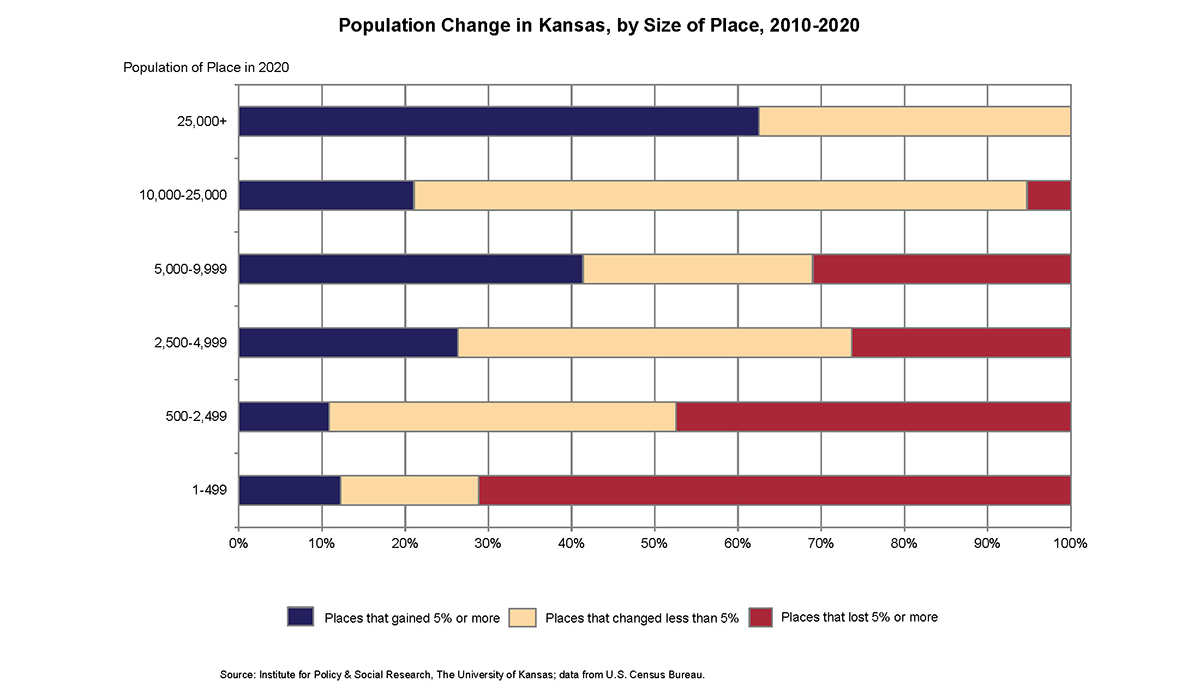55th edition of Kansas Statistical Abstract publishes new information on Kansas population and more

LAWRENCE — The newest edition of the Kansas Statistical Abstract is now available. This document, with the latest available data, offers information about Kansas across 16 categories, including population and vital statistics and health. The Institute for Policy & Social Research at the University of Kansas publishes this compendium of data annually.
The 55th edition of the abstract is informed in part by data collected during the 2020 U.S. census. Conducted every 10 years, the census aims to count each person in the country. Official population counts generated in each decennial census determine representation in Congress and apportion federal funding for states.
“Collecting census data in 2020 was complicated by the pandemic and legal challenges,” said Donna Ginther, Roy A. Roberts Distinguished Professor of Economics and director of IPSR. “These data are essential to government allocation of funds to Kansas and to assuring Kansans their right to representation. Through the Kansas Statistical Abstract, we are pleased to make census data available, and we look forward to adding new data as it becomes available.”
One graph in the abstract, “Population Change in Kansas, by Size of Place,” shows the change from 2010 to 2020 in the population of places grouped by their population size. It shows that places — including official and some unincorporated communities — that are smaller tended to lose population over the last decade while more populous places grew bigger.
A new map, “Percent Change in Housing Units in Kansas, by County,” shows that nine counties in Kansas lost over 10% of their housing units in the last decade. Only three Kansas counties, including Douglas County, gained an additional 10% or more housing units between 2010 and 2020. Changes in housing stock offer additional insight into the movement of people within the state from less populated to more populated places.
The abstract also has population data by congressional district. As the Kansas Legislature plans redistricting ahead of the next election cycle, the 2020 Census counts pose a challenge: the 1st Congressional District lost 2% of the population it had in 2010, while the 3rd Congressional District grew by 11%.
In addition, the abstract includes a new map of Census Designated Places. These are geographic areas with concentrated populations. They function as communities though they lack official incorporation as a township or other similar entity. Identifying a locality — such as Centerville and Monument in Kansas — means that the Census Bureau can collect and publish data about that place, which helps with emergency management and planning.
Xan Wedel, senior research data engineer, helped identify many of the new Census Designated Places for the 2020 Census as part of her work for the Kansas State Data Center. The Kansas SDC is a partnership between the U.S. Census Bureau and the state of Kansas and consists of a network of Kansas agencies. IPSR serves as the lead agency of the Kansas SDC.
“Understanding the demographic, social and economic characteristics of Kansas is important for business and community leaders as well as policymakers,” said Genna Hurd, IPSR associate researcher and KSA editor. “The KSA covers data on Kansas from health to housing, energy to employment, and poverty to population, including the census 2020 population for counties and cities. We are honored that IPSR and KU have been able to provide this service to the people of the state for 55 years.”
The abstract is used by government leaders, business owners, researchers and others throughout the state.
“There is an overwhelming amount of data available from an endless supply of sources,” said Janet McRae, economic development director for Miami County and frequent user of the abstract. “What I appreciate about the Kansas Statistical Abstract the most is how it saves me time by pulling together comparative, relevant data from reliable sources in a timely manner.”
The Kansas Statistical Abstract includes data in 16 categories published over 17 chapters: Sunflower State Summary; Agriculture; Banking and Finance; Business, Industry, and Exports; Climate; Communications and Information; Courts, Crime, and Public Safety; Education; Employment and Earnings; Energy and Natural Resources; Government; Housing and Construction; Income; Parks and Recreation; Population; Transportation; and Vital Statistics and Health.
The abstract is published both as a downloadable PDF file and in an online edition including downloadable Excel spreadsheets, PDFs and, where applicable, high-quality image files. The abstract is available to users at no cost.
Top image: “Population Change in Kansas, by Size of Place,” an image from the 55th edition of the Kansas Statistical Abstract. Credit: Institute for Policy & Social Research, KU.